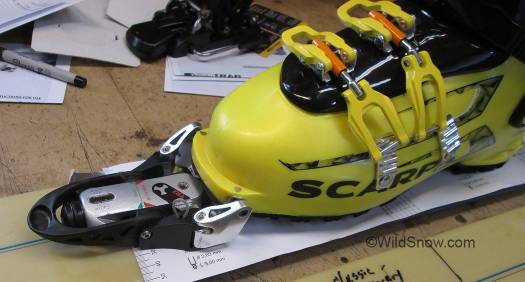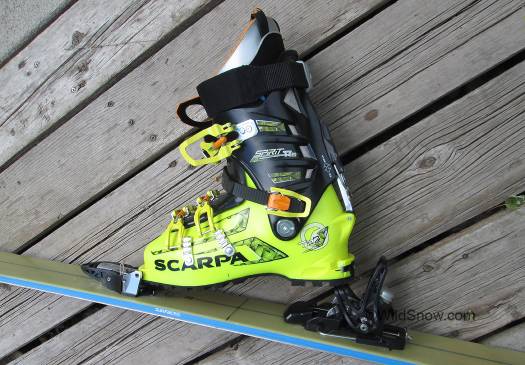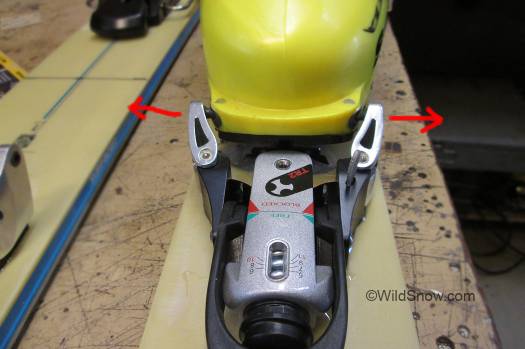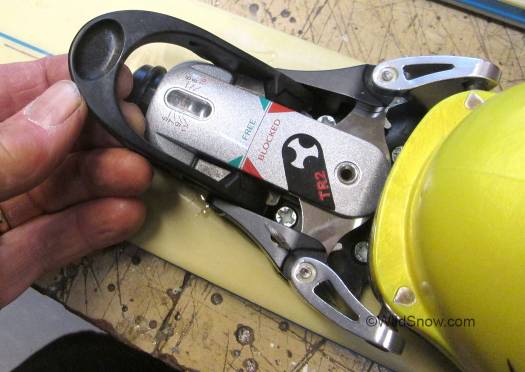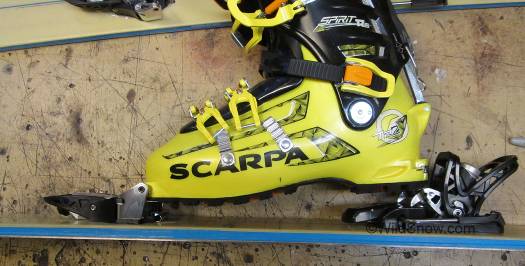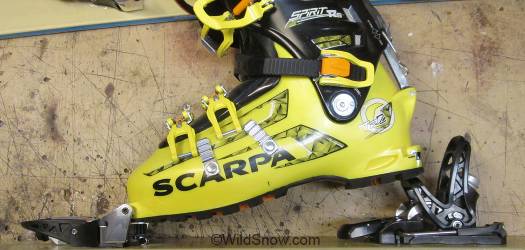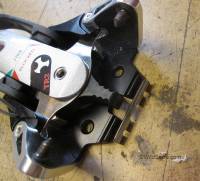Sometimes I have too many bindings and too little time. That happened last spring with the new TR2 from Trab. By the time I got my testers, battled my way out of website security administration issues and began fitting the dedicated boots, our snow had gone away as fast as the flock of private jets leaving Aspen two days after Christmas. (TR2 uses a proprietary “tech” like fitting in the boot, so I was limited to only one boot model from Scarpa; two models will be available this coming winter of 2014-15).
So I figured I’d do a mechanical analysis this summer, then get the on-snow testing done with plenty of time on the bindings as is our style — rather than a few hours at a demo or ski test. So stay tuned for that and check out the mech details below. Also be sure to peruse our prelim view of Trab TR2 from ISPO last winter.

Nice to have time for working through a paper template mount. In this case the template is well designed, easy to use.
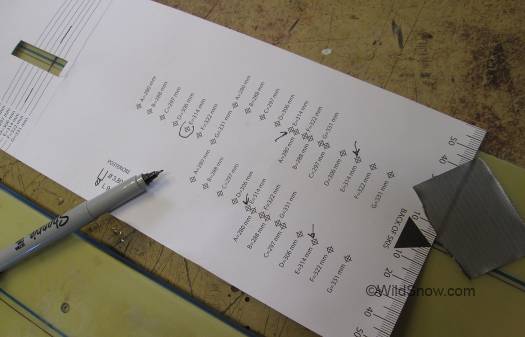
You pick a set of holes based on boot BSL; not sure why there are so many close together as the binding has a few centimeters of boot length adjustment. But nice to get it perfect.
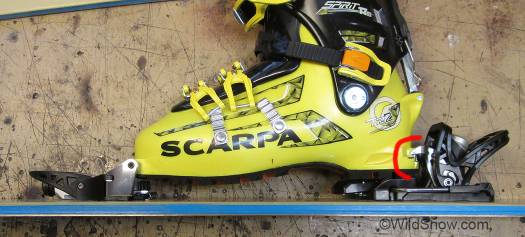
Side view, heel hold-down fork is visible. Small black mark is the approximate position pins would be in on a conventional tech binding.
The obvious design philosophy of TR2 is to provide a frameless binding that behaves much like an alpine binding. That happens in two ways, with caveats:
1. In lateral (side) safety release the toe wings open to the side. Not only that, but the binding toe wings provide about 12 mm of travel/elasticity as the boot toe moves to the side. While the binding does have a release lockout for touring (or extreme descents) it appears it’ll be 100% safe and functional during normal skiing, without fully locking out release as many people do with various brands and models of tech bindings.
2. Unlike a conventional tech binding, the boot heel is totally locked from any side travel by a steel fork that presses down over the boot heel ledge and a metal fitting that takes the place of the usual tech fitting. The fork presses on the boot heel under spring tension as well as being noticeably rigid to twisting (meaning the boot shoe twisting as viewed from the front or rear. With a normal tech binding, the boot resists twisting mainly by virtue of the rigid toe unit; the heel is only held by the two small pins in a narrow pattern. While tech bindings are incredibly rigid, the boot can still twist. More importantly, with tech bindings that release laterally at the heel you’ll get constant movement in the heel while skiing. TR2 locks your boot in at the heel at least as effectively as an alpine binding, and in my opinion more so. Is that kind of rigidity necessary? Depends on what you’re doing, but a binding that’s “too solid” is always better than a sloppy wriggly throwback to the 1970s, as many frame bindings are.
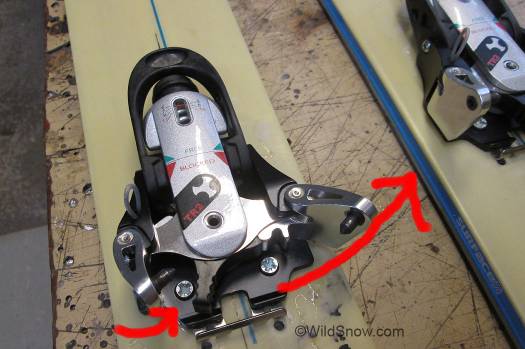
Wings in open position after safety release to the right. To reset you have to move the black plastic tab (between arrows) over and snap the wing back into place–an extra step compared to most other touring bindings but easy and quick once you get the hang of it.
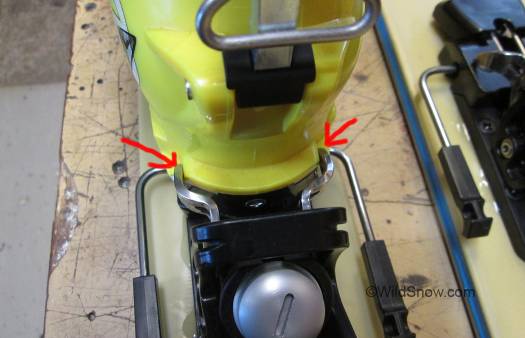
Heel unit steel ‘fork’ holds the boot down and centered. Solid. Same as toe, heel doesn’t click open or closed; it is constantly under spring load. That’s a simple way to engineer things, but doesn’t lend itself to any possible step-in capability. To get out of the binding you have to press hard with a ski pole on the heel lever, momentarily holding it open while you pull your heel up and out. More, to exit the binding while in downhill mode you actually have to take your heel out first, the press the toe lever down or twist your boot toe out of the toe unit.
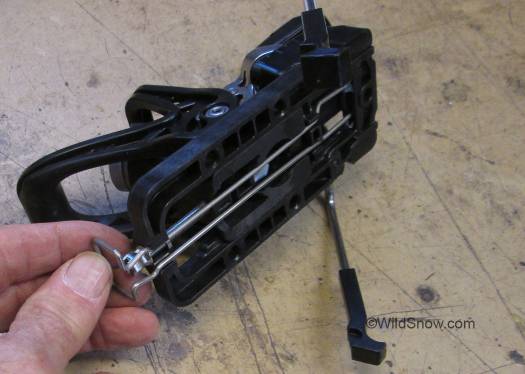
I really like Trab’s basic system of locking the brake up in touring mode. Elegant. Two rods slide forward/backward to hold the brake. Only issue is this is done manually and somewhat of an extra step when switching modes.

Underside of heel unit viewed from front showing how the rods of the brake lock hold the retractor plate until pulled rearward.
Observations:
– Getting in and out is somewhat fiddly. Unlike most other tech bindings, with Trab TR2 you have to have your boot heel in touring mode before you can exit the toe. More, the toe doesn’t click open and stay, instead you hold it open by pressing your ski pole down on a spring loaded lever (similar to another brand/model that never caught on). I’ve found this method of entering and exiting a tech type binding to be problematic in many ways. It’s difficult in deep powder, and awkward on steep hard snow.
– If you experience a safety release at the toe, the binding has to be re-set. Doing so is easy, but an extra step as well as learned behavior.
– Stowing and retracting the brake is somewhat of an extra step compared to the better brake systems on the market.
– Lowest heel height in touring mode is significantly jacked up from being flat.
– Proprietary fittings. It took thirty years for regular tech fittings to become a virtual standard. Kudos to Trab for having the cajones to start the whole process over again. On the plus side, perhaps they’ll break out of the “tyranny of the fittings” and enjoy the freedom to fix everything problematic about the current tech system.
On the other hand, the economics of standards often reap huge benefit for consumers — even a non-official standard such as tech bindings. To confuse an already small (compared to alpine skiing) market with another dedicated binding/boot system could be hard on everyone involved.
However, on that same note I was delighted to hear at ISPO that Trab had no big agenda to achieve certification to current ski touring binding DIN/ISO standards, since heading down the rabbit trail of making a tech type binding that conforms to archaic frame binding standards may stifle innovation in terms of real-world performance (a widely acknowledged downside of standards in any industry). Truly, there is nothing sadder than a brain trust of engineers ignoring real world problems and instead focusing on how to adhere to a standard. The tire inflation warning systems on later model automobiles are a good example. They conform to a standard and probably took immense amount of human and monetary capital to create, but fail miserably in real life. What a waste.
Conclusion thus far:
The solid feel and excellent elasticity of Trab TR2 could make it a functional freeride binding. In particular, we like the excellent elasticity of the toe unit. While the binding does have a few added fiddle factors, they’re probably something users can adjust to fairly quickly. Too early to tell if it’ll catch on, but will most certainly be interesting to watch.
Factoids
– Wildsnow verified weights:
— Total one binding with screws and 104 mm brake, 22.1 oz, 628 gr.
— Toe with screws and crampon mount, 8.9 oz, 254 gr.
— Heel with screws and 194 mm brake, 13.2 oz, 372 gr.
— Brake (104 mm), 3.6 oz, 102 gr.
– Max release value: Original model goes from RV 5 to 11. Coming this fall, 7/13 model will be available.
– Not tech system compatible, is its own proprietary system that requires dedicated boots.
– Available boot for 2014 was 3-buckle Scarpa Spirit TR2.
– This coming winter of 2014/2015 a stiffer boot will be on tap, 4-buckle Scarpa Spirit RS TR2.
– Delta/ramp is 2 millimeters heel lower than Dynafit TLT, 5 mm lower than Dynafit Radical.
– Boot length adjustment range: 23 mm.
– Brake widths available 88, 104, 115.
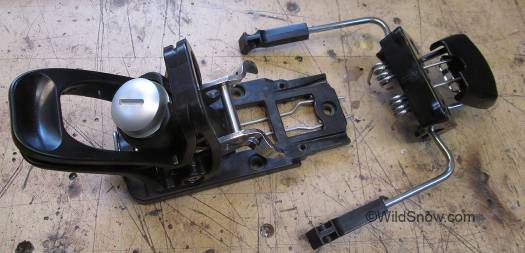
Brake is easy to remove, though you’d need to run the binding with the heel block. Note the brake lock rods visible. Unknown if Trab will supply a non-brake heel block. I necessary it’s easy to remove the brake arms and springs from the heel block and re-install.
WildSnow.com publisher emeritus and founder Lou (Louis Dawson) has a 50+ years career in climbing, backcountry skiing and ski mountaineering. He was the first person in history to ski down all 54 Colorado 14,000-foot peaks, has authored numerous books about about backcountry skiing, and has skied from the summit of Denali in Alaska, North America’s highest mountain.

